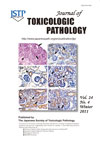Volume 14, Issue 4
Displaying 1-12 of 12 articles from this issue
- |<
- <
- 1
- >
- >|
Originals
-
Article type: Original
Subject area: None
2001 Volume 14 Issue 4 Pages 259
Published: 2001
Released on J-STAGE: December 22, 2001
Download PDF (275K) -
Article type: Original
Subject area: None
2001 Volume 14 Issue 4 Pages 267
Published: 2001
Released on J-STAGE: December 22, 2001
Download PDF (240K) -
Article type: Original
Subject area: None
2001 Volume 14 Issue 4 Pages 273
Published: 2001
Released on J-STAGE: December 22, 2001
Download PDF (228K) -
Article type: Original
Subject area: None
2001 Volume 14 Issue 4 Pages 279
Published: 2001
Released on J-STAGE: December 22, 2001
Download PDF (567K) -
Article type: Original
Subject area: None
2001 Volume 14 Issue 4 Pages 289
Published: 2001
Released on J-STAGE: December 22, 2001
Download PDF (620K) -
Article type: Original
Subject area: None
2001 Volume 14 Issue 4 Pages 299
Published: 2001
Released on J-STAGE: December 22, 2001
Download PDF (1003K)
Case Reports
-
Article type: Case Report
Subject area: None
2001 Volume 14 Issue 4 Pages 305
Published: 2001
Released on J-STAGE: December 22, 2001
Download PDF (378K) -
Article type: Case Report
Subject area: None
2001 Volume 14 Issue 4 Pages 309
Published: 2001
Released on J-STAGE: December 22, 2001
Download PDF (401K)
JTP Forum
-
Article type: None
Subject area: None
2001 Volume 14 Issue 4 Pages 313
Published: 2001
Released on J-STAGE: December 22, 2001
Download PDF (375K)
Session Summary “Society of Toxicologic Pathologists and the International Federation of Societies of Toxicologic Pathologists”
-
Article type: None
Subject area: None
2001 Volume 14 Issue 4 Pages 319
Published: 2001
Released on J-STAGE: December 22, 2001
Download PDF (87K) -
Article type: None
Subject area: None
2001 Volume 14 Issue 4 Pages 321
Published: 2001
Released on J-STAGE: December 22, 2001
Download PDF (136K) -
Article type: None
Subject area: None
2001 Volume 14 Issue 4 Pages 327
Published: 2001
Released on J-STAGE: December 22, 2001
Download PDF (106K)
- |<
- <
- 1
- >
- >|
